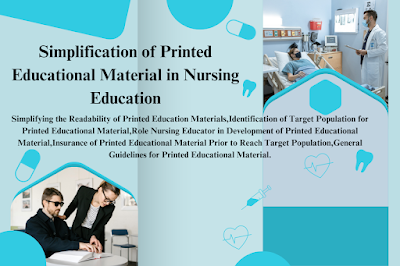Simplification of Printed Educational Material in Nursing Simplifying the Readability of Printed Education Materials
Readability Considerations:
- Grade Level: Readability formulas can assess the grade level required to understand the material. However, readability alone does not ensure effective communication. Consider other factors such as technical format, concept density, and message clarity.
- Technical Format: Ensure the format is accessible. This includes clear headings, bullet points, and a logical flow that guides the reader through the content.
- Concept Density: Avoid overloading the material with too much information at once. Break down complex concepts into simpler parts.
- Accuracy and Clarity: Use precise language and avoid jargon. Make sure the content accurately conveys the intended message in a straightforward manner.
Identification of Target Population for Printed Educational Material
Understanding the Audience:
- Motivation: Assess the motivation of the target audience. Even well-written material can be ineffective if the audience is not motivated to read or engage with it.
- Reading Abilities: Determine the reading levels of your audience. Materials should be written at a level that is accessible to the majority of the audience.
- Experiential Factors: Consider the audience’s prior knowledge and experience related to the health topic. Tailor the content to build on what the audience already knows.
- Cultural Background: Ensure the material is culturally sensitive and relevant to the audience’s background. Avoid cultural biases and include examples that resonate with the target population.
Challenges:
- Even well-motivated readers may struggle with complex materials, which are often written at a higher reading level than necessary (Winslow, 2001; Monsivais & Reynolds, 2003).
Role of Nursing Educator in Development of Printed Educational Material
Responsibilities:
- Fit Between Material and Reader: Strive to match the material with the reader’s comprehension level. This involves choosing appropriate content and language that resonates with the audience.
- Improving Comprehension: While improving general education is ideal, focus on creating materials that are accessible based on current literacy levels. This includes applying linguistic, motivational, organizational, and content principles to enhance readability (Williams, Muir, & Rosdahl, 2016).
- Effort in Writing: Recognize that creating clear and effective materials requires significant effort. Follow best practices in writing to ensure the material is engaging and understandable.
Insurance of Printed Educational Material Prior to Reaching Target Population
Preliminary Planning Steps:
- Define Objectives: Clarify what the client should learn or do as a result of the instruction. Set clear behavioral objectives for the material.
- Select Relevant Information: Choose information that is essential for achieving the objectives. Avoid unnecessary details and focus on survival skills and key concepts.
- Supplementary Media: Use additional media (e.g., visuals, audio, video) to support the written material. This can enhance understanding and engagement.
- Organize Content: Structure the material logically, prioritizing important information and presenting it in a clear sequence. Place key facts at the beginning and end of lists.
- Determine Reading Level: Write at a reading level appropriate for the audience. If unsure, aim for a 5th-grade level, which covers a broad range of reading skills. Include reading level indicators on the material.
Literature Reference: Consult resources on effective educational material development (Aldridge, 2004; Doak et al., 1996; Weiss, 2007) for additional guidelines and techniques.
General Guidelines for Printed Educational Material
Key Strategies:
- Conversational Style: Use a conversational tone with personal pronouns (e.g., “you” and “your”). An active voice in the present tense makes instructions clearer and more engaging (e.g., “Take your medicine” vs. “Medicine should be taken”).
- Clarity and Directness: Address the reader directly and use simple, clear language. Avoid passive voice and complex sentence structures.
- Visual Format: Incorporate visuals, such as images and diagrams, to support and clarify the text. Ensure the layout is user-friendly and enhances readability.
- Engagement: Make the material appealing by using motivational elements and ensuring relevance to the reader’s needs.
Example of Effective Writing:
- Less Effective: “People who sunburn easily and have fair skin with red or blonde hair are most prone to develop skin cancer. The amount of time spent in the sun affects a person’s risk of skin cancer.”
- More Effective: “If you have fair skin, red or blonde hair, and burn easily in the sun, you are more likely to get skin cancer. Spending a lot of time in the sun increases your risk.”
By following these guidelines, nursing educators can create printed educational materials that are more effective in communicating essential health information and improving patient understanding and engagement.
4o mini
